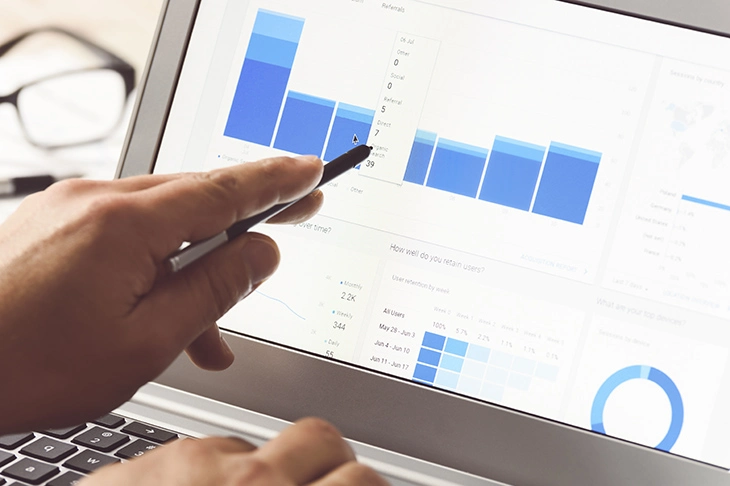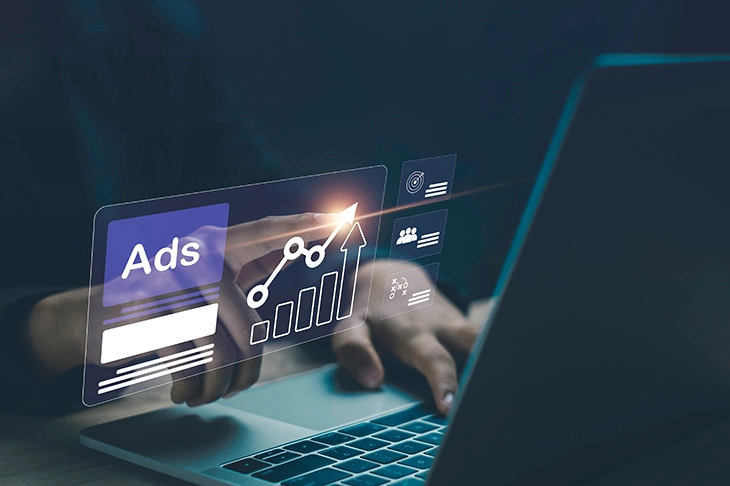Heidi Bodfish Digital Account Manager
- Social Media
The role of social media advertising for B2B companies.
With over five billion social media users worldwide, the opportunity for organic social success has become very slim. It’s not impossible, but we’re a far cry from where we were just five years ago. Heidi Bodfish, our Digital Account Manager, discusses social media advertising and why we cannot rely on organic content in 2024.

The rise of social media advertising.
Social media advertising is a fundamental part of any digital marketing strategy – or at least, it should be. In 2024, there are estimated to be 5.17 billion social media users, each using 6.7 social platforms. This is an intimidating figure, but one that presents countless opportunities for B2B brands – in that five billion, your customers are there, present and engaged.
In today’s crowded digital landscape, reaching and engaging your target audience is increasingly challenging. With organic reach declining across all platforms, the days of simply clicking ‘publish’ and hoping for the best are over. For B2B brands looking to enhance their social media marketing and connect with international audiences, supporting organic content with targeted advertising spend is essential.

What is social media advertising?
A social media ad campaign will help B2B brands deliver content directly to a specific audience. It is a quick, effective, and measurable way to communicate value propositions and brand messages to customers, prospects, and entirely new demographics. When optimised correctly, ads can offer a substantial return on investment compared to more traditional forms of advertising.
Ads come in various forms—written content, downloads, images or graphics, videos, carousels or even conversational messages—providing numerous opportunities to create unique content that complements wider social media activities. However, optimising your company page and building up an organic presence before deploying an ad is important, so those who click on the CTA aren’t met with an empty or unprofessional page.
Stop the scroll—here is an example of a social media campaign that combined both organic and paid-for social media content.
What are the main social media platforms to advertise on?
As you should know, most social media platforms accommodate paid-for posts, and although B2B brands tend to focus more on LinkedIn, Facebook and YouTube – Instagram, X, TikTok and even Reddit present (often) untouched opportunities. But for now, we will discuss the most important channels for B2B businesses operating within complex sectors.
Facebook.
To kick off, though – we’ll start with Facebook. If you’ve heard Gen Z say “who’s on Facebook? It’s dead”, please take that with a singular grain of salt. “Facebook remains an advertising powerhouse” and continues to be used by many brands, particularly across the B2B sector. Although today’s youth have migrated to TikTok and SnapChat, Facebook is still one of the most used platforms worldwide. And as users, on average, tend to be older – 25 years old and onwards – B2B brands are more likely to be engaging with users that are established and in higher positions of authority.
Instagram.
When it comes to demographics, Instagram is similar to Facebook. But where the platform differs is in its engagement rates—Instagram has four times higher engagement rates, which we can predict comes from Reels and the higher volume of video content across the platform. Furthermore, data from Meta revealed that 80% of users rely on Instagram when making buying decisions.
X (Formerly Twitter).
For several reasons, Twitter’s decline has made it less suitable for B2B marketing. Twitter user engagement has been declining, reducing the potential reach and impact of B2B ads. This may be due to ongoing controversies and negative publicity surrounding Twitter and how it impacts the credibility and perception of brands advertising on the platform. Plus, the company changeover has resulted in frequent algorithm changes, making it difficult for B2B content to reach the target audience consistently.
In turn, users are experiencing ad fatigue due to the high volume of ads, leading to lower engagement and effectiveness. This isn’t great, considering X offers fewer ad targeting options and demographics at a higher price. Therefore, platforms like LinkedIn, Meta, Reddit, Pinterest, and TikTok offer more effective targeting, higher engagement rates, and better ROI for B2B marketers.
LinkedIn.
Of course, the go-to platform for B2B brands is LinkedIn. What was once a place to share company news and advertise roles, LinkedIn has grown exponentially with more than one billion members, 67 million company profiles and, as its largest age group at 31% are 30–39-year-olds, there are plenty of opportunities to create ads that go straight to decision-makers and people of influence.
TikTok.
TikTok is increasingly used as a search engine rather than just a social platform, making it valuable for B2B companies. Users, especially younger demographics, search TikTok for product reviews, tutorials, and industry insights, favouring its engaging, visual content. Short videos effectively showcase complex products and services, particularly in different types of design.
TikTok’s algorithm searches relevant content, boosting engagement. It also enables influencer partnerships to tap into established audiences and leverage trends to enhance relevance and visibility. Sharing industry tips and insights positions companies as thought leaders. TikTok’s paid ads can further amplify reach, targeting specific audiences and increasing ROI through optimised ad campaigns. This combination of organic and paid strategies makes TikTok a powerful tool for B2B marketing.
YouTube.
Despite the emergence of TikTok, YouTube continues to be the go-to platform for video content. In fact, it’s the second-largest search engine in the world. YouTube’s 2.1 billion users watch an estimated 45 minutes of video content daily, making it an essential platform for targeted ads to reach the right audiences.
Reddit.
Reddit used to be viewed as a taboo corner of social media. However, due to its recent partnership with Google, it is now seen as a valuable search platform. Don’t get me wrong—all platforms still have their dark corners if you look hard enough. But Reddit has some key B2B benefits. First, it has improved SEO functionality, incorporating keywords that increase visibility for B2B ads targeting particularly specific industry-related topics.
As well as access to specialised subreddits which aren’t available anywhere else, reaching highly relevant audiences and maximising ROI. Users trust content within their communities, leading to better reception and interaction with ads, which leads to valuable user data for future campaigns. Reddit threads remain active longer – maintaining ad visibility over time. All of this, combined with the fact Reddit’s ads are competitively priced compared to other platforms, make it a powerful marketing tool.
Pinterest is a valuable platform for visual discovery in B2B marketing, showcasing visually appealing products, designs, and infographics to high-intent users who often browse with specific projects in mind, leading to higher engagement and conversion rates. This allows targeting of specific interests and industries, allowing a platform for how-to guides, case studies, and industry insights which present B2B companies as thought leaders.
Like Reddit’s Keyword capabilities, Pinterest ‘Pins’ are indexed by search engines such as Google, boosting organic traffic. These features make Pinterest effective for reaching and engaging B2B audiences, driving brand awareness, and generating leads for a much more considerable price.

What benefits does advertising bring to your B2B social media marketing strategy?
Firstly, social media advertising will enable you to create hyper-targeted content based on gender, age, job title, behaviours, location and interests. You can define the precise parameters that meet your customer’s or prospect’s expectations. With this ability, you can confidently start a social media advertising campaign knowing that you’re going to generate results at lower costs than comparable marketing tactics. As you can see from the average cost-per-click, you can control spending, maximise efficiency and manage your investment from start to finish.
A benefit of advertising is brand awareness and exposure. We cannot rely on organic posts maybe being viewed in your target audience’s feed anymore – and often, users may not have time or are not in the habit of going direct to your company page. Adverts will enable your brand presence and support additional content, ensuring that your identity is seen in various forms across chosen platforms to create memorable touchpoints.

What are the key components of a social media advertising campaign?
Start with a clear outline.
When approaching a social media advertising campaign, it is important to understand your objectives. Are you hoping to boost brand awareness? Do you want to drive traffic to a specific landing on your website? Or are you hellbent on converting and increasing sales?
Be aware of your target audience.
Like any campaign, you must know your audience. Where are they? Which content do they engage with? What are their interests? Are they senior stakeholders and decision-makers?
Choose the right platform for your audience.
Campaign objectives and who you’re targeting have a huge bearing on your chosen platform. Although LinkedIn is the optimum choice for professionals, are business leaders seeing the ads and actively making decisions? Or are they scrolling Facebook in the evening when there is more time to think? Should you capture these individuals at this point rather than at 2 pm on Wednesday?
Create engaging creative assets.
This is the fun bit. There are many ways to design creative assets that differentiate your content – videos, infographics, interactive content, and short, sharp questions or phrases will attract attention. Remember, it has to be eye-catching, and it must convey your message instantly.
Your target audience won’t want to (or have time to) investigate what you’re trying to say. Keep it short; keep it succinct. Additionally, visual a/b testing is important as different visuals can significantly impact how users interact with an ad. This optimisation helps achieve a higher return on investment (ROI) by reducing wasted ad spend on less effective visuals.
Set the right budget and targets.
You’ll now be able to explore budgets and timings. What are you willing to spend, and at what times of day? Exploring all possibilities is important so you’re not wasting time or money. Each platform can provide extensive information on all these details so that you can set your parameters, schedule, and manage all ads effectively.